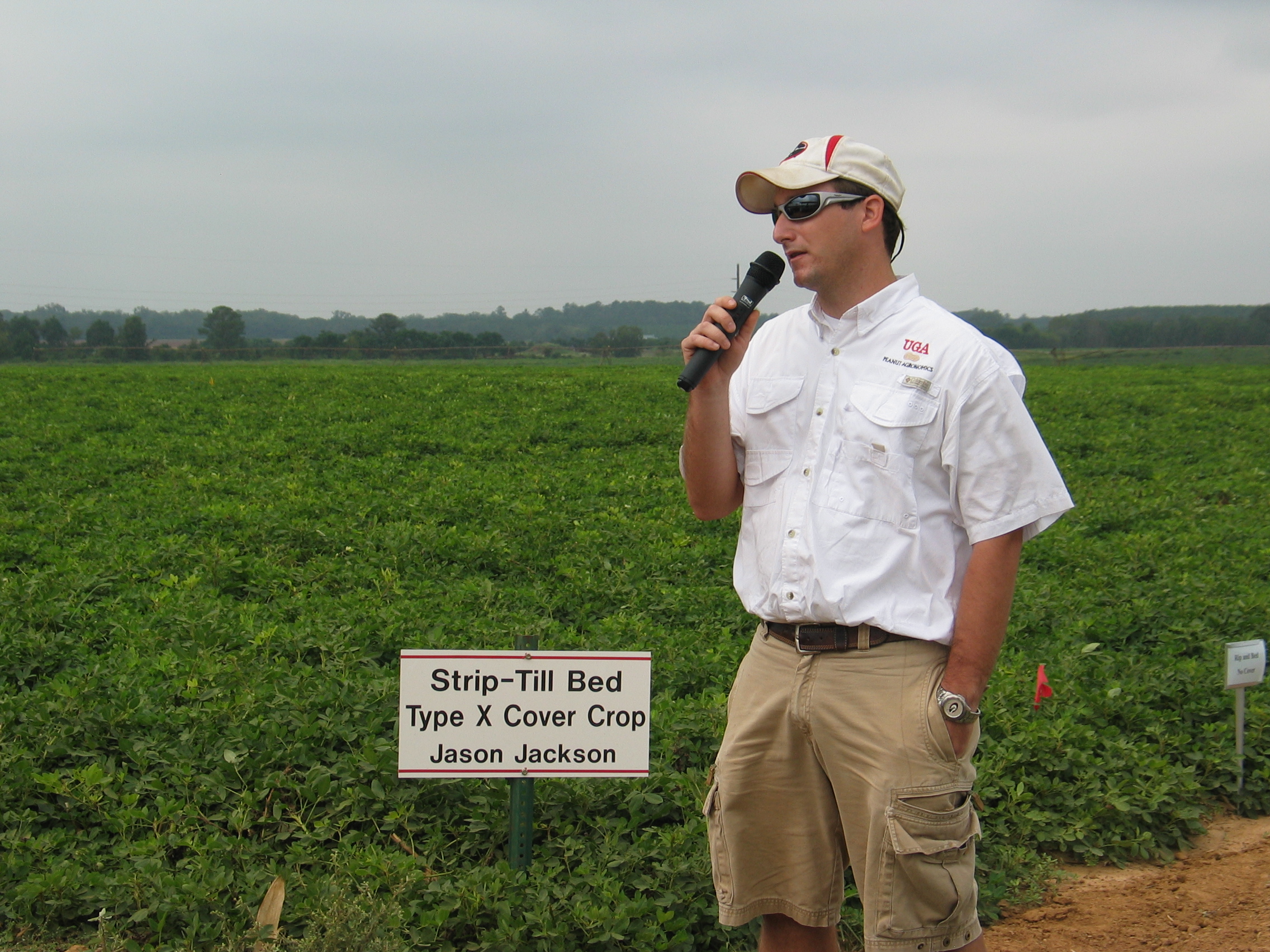 Jason Jackson, a University of Georgia student pursuing his master’s degree in agronomy, presented information on his research project during the stop at the Southwest Georgia Research and Education Center. Jackson grew up on a farm in Cuthbert, Ga., and knows first hand the digging losses that occur with strip-till peanuts in that area. This is unlike other areas of the state that have sandy soils. In fact research has shown an increase in yield by using strip-till versus conventional. However, the increase in projected yield does not help farmers in red clay soil areas that have suffered digging losses when using strip-till. Strip-till helps to conserve moisture and prevent erosion so Jackson came up with a new method utilizing strip-till that he hopes will also reduce digging losses for farmers in his area. In the research project, Jackson planted the variety Georgia 02C on a flat bed, raised bed (7″ high) and standard ripping bed (12 or 14″ high). The beds were made in the fall and a cover crop planted on the bed. In a 2007 test in Tifton, Ga., Jackson did not see any difference in results on digging loss or yield when comparing the flat and raised strip-till beds. However, there were differences in Plains, Ga. amounting to $150 per acre advantage. The 2007 research showed 1,200 pounds per acre digging loss on a flat bed and 600 pounds per acre digging loss on a ripping bed when using strip-till. The 600 pound difference in yield loss equals to a $150 per acre advantage when farmers use strip-till on a raised bed. The cost to prepare a bed is about $30 per acre. These results are from the first year of this study and the 2008 data should be available soon. Keep in mind that this research project has not been completed for three years so researchers on the University of Georgia Peanut Team are not recommending this as a practice yet for farmers.
Jason Jackson, a University of Georgia student pursuing his master’s degree in agronomy, presented information on his research project during the stop at the Southwest Georgia Research and Education Center. Jackson grew up on a farm in Cuthbert, Ga., and knows first hand the digging losses that occur with strip-till peanuts in that area. This is unlike other areas of the state that have sandy soils. In fact research has shown an increase in yield by using strip-till versus conventional. However, the increase in projected yield does not help farmers in red clay soil areas that have suffered digging losses when using strip-till. Strip-till helps to conserve moisture and prevent erosion so Jackson came up with a new method utilizing strip-till that he hopes will also reduce digging losses for farmers in his area. In the research project, Jackson planted the variety Georgia 02C on a flat bed, raised bed (7″ high) and standard ripping bed (12 or 14″ high). The beds were made in the fall and a cover crop planted on the bed. In a 2007 test in Tifton, Ga., Jackson did not see any difference in results on digging loss or yield when comparing the flat and raised strip-till beds. However, there were differences in Plains, Ga. amounting to $150 per acre advantage. The 2007 research showed 1,200 pounds per acre digging loss on a flat bed and 600 pounds per acre digging loss on a ripping bed when using strip-till. The 600 pound difference in yield loss equals to a $150 per acre advantage when farmers use strip-till on a raised bed. The cost to prepare a bed is about $30 per acre. These results are from the first year of this study and the 2008 data should be available soon. Keep in mind that this research project has not been completed for three years so researchers on the University of Georgia Peanut Team are not recommending this as a practice yet for farmers.
The Peanut Biodiesel Project
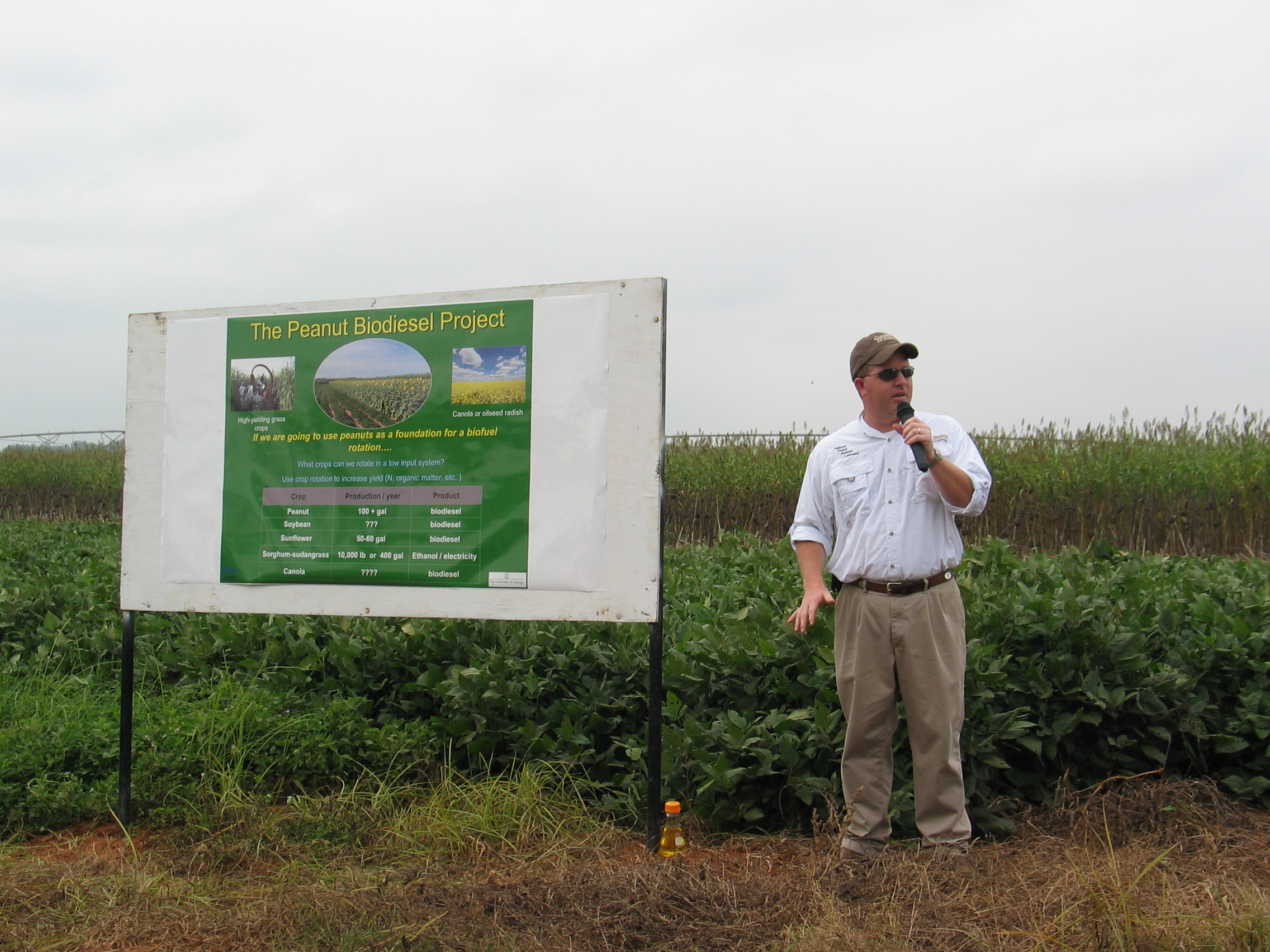 Wilson Faircloth, researcher with the USDA National Peanut Research Lab in Dawson, Ga., discussed the Peanut Biodiesel Project with the Georgia Peanut Tour attendees. Faircloth showcased the research he and other researchers are working on with production systems at the Southwest Georgia Research and Education Center. Faircloth has been working the last three years to develop production systems and look at peanut varieties that would be suitable for biodiesel. With this project he has had to throw out the old way of growing peanuts and look at completely new methods. One example is reviewing some peanut varieties that did not work in the industry because of shelling characteristics or taste. Those peanut varieties may not have worked for consumption but they could possibly work for biodiesel. Through this project Faircloth has been able to produce biodiesel for $2.65.
Wilson Faircloth, researcher with the USDA National Peanut Research Lab in Dawson, Ga., discussed the Peanut Biodiesel Project with the Georgia Peanut Tour attendees. Faircloth showcased the research he and other researchers are working on with production systems at the Southwest Georgia Research and Education Center. Faircloth has been working the last three years to develop production systems and look at peanut varieties that would be suitable for biodiesel. With this project he has had to throw out the old way of growing peanuts and look at completely new methods. One example is reviewing some peanut varieties that did not work in the industry because of shelling characteristics or taste. Those peanut varieties may not have worked for consumption but they could possibly work for biodiesel. Through this project Faircloth has been able to produce biodiesel for $2.65.
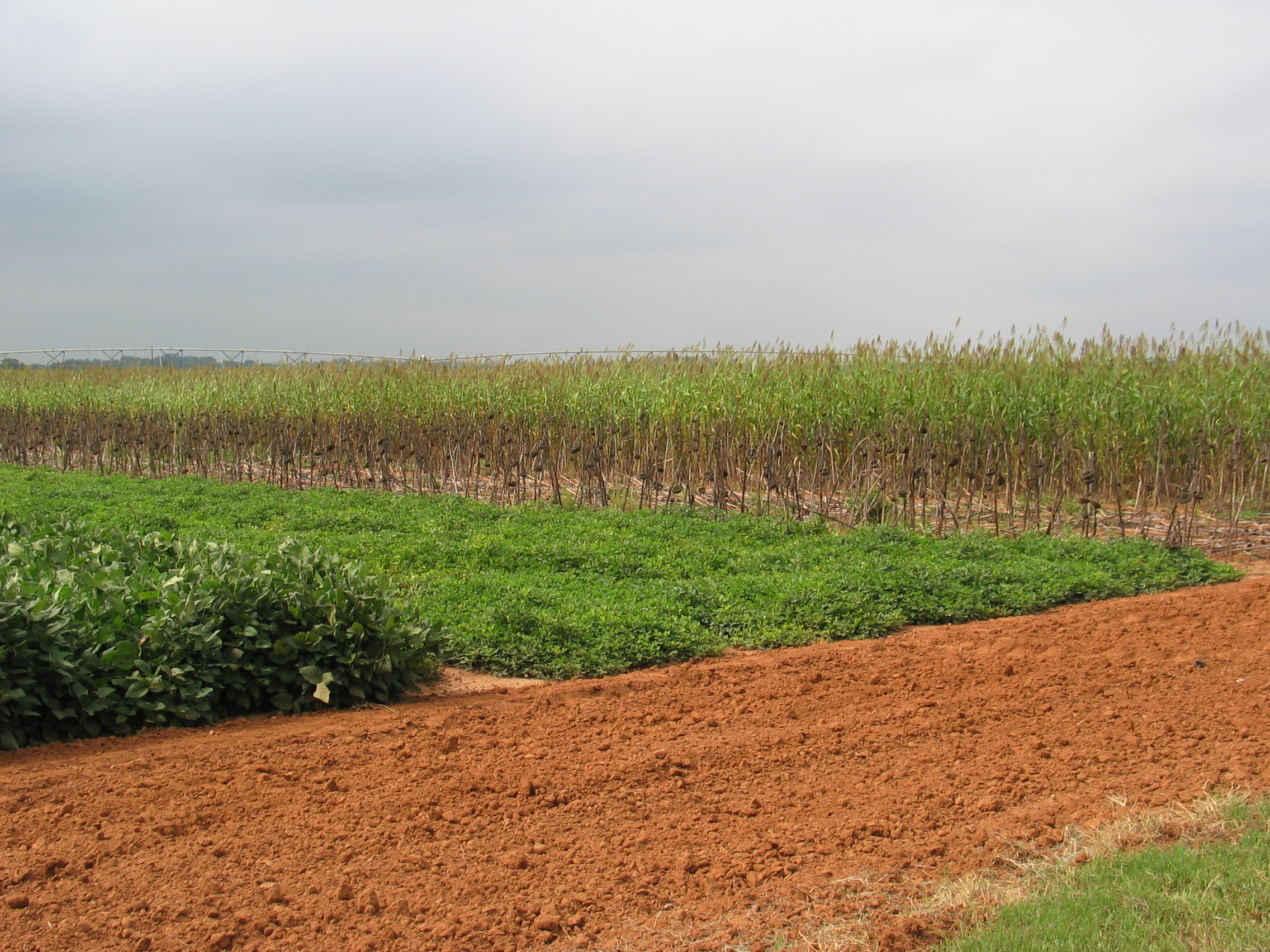 The biofuel rotation study at the Southwest Georgia Research and Education Center involves peanuts, soybean and sunflowers during the summer. The rotation during the winter consists of canola and oilseed radish. This is the first year of this rotation study but Faircloth predicts the yield for biodiesel at 100 gallons per acre from peanuts, 65 gallons per acre from soybeans, 50 to 60 gallons per acre from sunflowers and 75 gallons per acre from canola. In the rotation, Faircloth is also growing Sorghum-Sudan Grass for ethanol. Approximately 10,000 pounds of dry matter of the grass would producer 400 gallons of ethanol. By using the biofuel rotation this would provide a farmer with a flow of material throughout the year. Of course Faircloth does not want farmers to stop growing peanuts for consumption. Instead he recommends that farmers set aside a small acreage for their biodiesel. Farmers would also have to throw out the old way of thinking when it comes to controlling disease or weeds in the field. The peanuts grown for biofuel can be grown with fewer inputs than peanuts grown for consumption. Peanuts have the highest oil potential in the Southeastern U.S. so with this biofuel rotation study farmers may find just what they need to supply fuel for their farm.
The biofuel rotation study at the Southwest Georgia Research and Education Center involves peanuts, soybean and sunflowers during the summer. The rotation during the winter consists of canola and oilseed radish. This is the first year of this rotation study but Faircloth predicts the yield for biodiesel at 100 gallons per acre from peanuts, 65 gallons per acre from soybeans, 50 to 60 gallons per acre from sunflowers and 75 gallons per acre from canola. In the rotation, Faircloth is also growing Sorghum-Sudan Grass for ethanol. Approximately 10,000 pounds of dry matter of the grass would producer 400 gallons of ethanol. By using the biofuel rotation this would provide a farmer with a flow of material throughout the year. Of course Faircloth does not want farmers to stop growing peanuts for consumption. Instead he recommends that farmers set aside a small acreage for their biodiesel. Farmers would also have to throw out the old way of thinking when it comes to controlling disease or weeds in the field. The peanuts grown for biofuel can be grown with fewer inputs than peanuts grown for consumption. Peanuts have the highest oil potential in the Southeastern U.S. so with this biofuel rotation study farmers may find just what they need to supply fuel for their farm.
National Peanut Research Lab Peanut Biodiesel Project
2008 Georgia Peanut Tour Photo Album
Rodney Dawson video on the Peanut Intensive Management Program
MVI_8445
Originally uploaded by Georgia Peanut Commission
Rodney Dawson, Pulaski County peanut farmer and Georgia Peanut Commission board member, discusses his farm operation to the Georgia Peanut Tour attendees on Wednesday, Sept. 17, 2008. Dawson farms with his brothers, Gary & John Dawson, Jr. They utilize the Peanut Intensive Management Program and through the scouting services of Emily Evans they are seeing a savings in their irrigation and fungicide applications. There is more information on Dawson Brothers Farm and the Intensive Management Program in earlier posts on this blog.
Chris Martin video
Originally uploaded by Georgia Peanut Commission
Here’s a short video clip of Chris Martin, Pulaski County farmer, on the 2008 Georgia Peanut Tour. He is discussing the transition he is making to growing organic peanuts on a small scale. There is an ealier post with more detail on the transition and what he has learned.
Southwest Georgia Research & Education Center
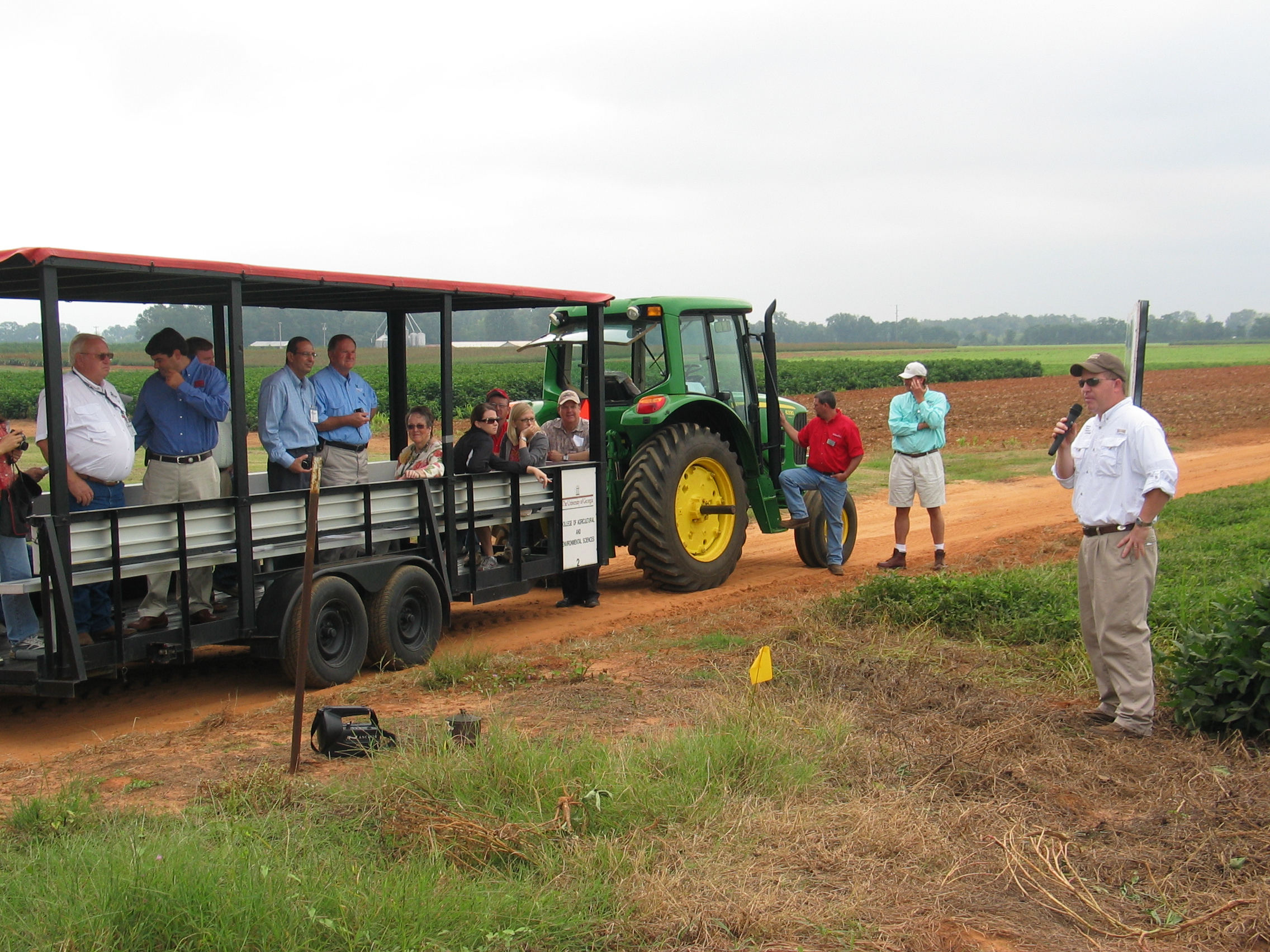 The next stop in the Plains, Ga. area highlighted peanut research through the University of Georgia and the U.S. Department of Agriculure. The group visited the Southwest Georgia Research and Education Center which was established in 1951. The center now maintains 512 acres and the U.S. Department of Agriculture has developed a foundation seed processing unit and the Department of Industry and Trade has created a welcome center for visitors to former President Jimmy Carter’s hometown. The site was selected years ago based on its heavy red clay soil which is predominant in this region of the state. This soil type can be difficult to farm but can be very productive when carefully managed.
The next stop in the Plains, Ga. area highlighted peanut research through the University of Georgia and the U.S. Department of Agriculure. The group visited the Southwest Georgia Research and Education Center which was established in 1951. The center now maintains 512 acres and the U.S. Department of Agriculture has developed a foundation seed processing unit and the Department of Industry and Trade has created a welcome center for visitors to former President Jimmy Carter’s hometown. The site was selected years ago based on its heavy red clay soil which is predominant in this region of the state. This soil type can be difficult to farm but can be very productive when carefully managed.
Current research at the center focuses on every major crop in South Georgia including peanuts, cotton, corn, soybeans, grain sorghum, wheat and canola. Researchers also study peaches and pecans. Animal scientists conduct breeding and forage studies using the station’s 75 head cow-calf herd. Researchers are conducting several research projects specific to peanuts and those include peanut variety trials at the center, herbicide tolerance in peanuts, peanut fungicide screening and economic analysis of peanuts.
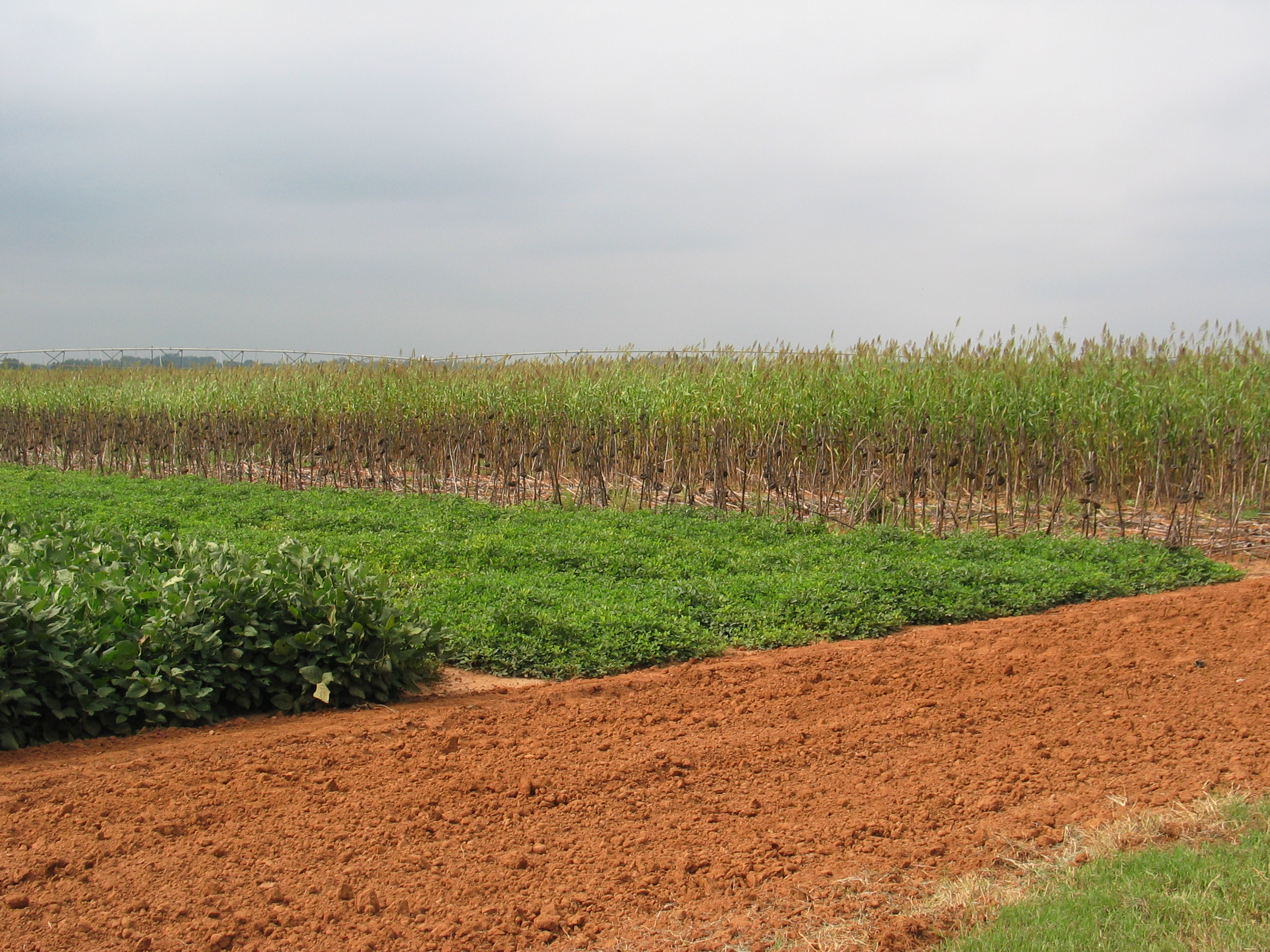 About 40 percent of the center’s budget improves the quality of life for all Georgians. It provides vital benefits for the state’s agriculture industry, but it also reaches far beyond the farm. Agricultural research helps provide safer and more nutritious foods, a cleaner environment, new industries and more comfortable homes and communities throughout the state.
About 40 percent of the center’s budget improves the quality of life for all Georgians. It provides vital benefits for the state’s agriculture industry, but it also reaches far beyond the farm. Agricultural research helps provide safer and more nutritious foods, a cleaner environment, new industries and more comfortable homes and communities throughout the state.
Stan Jones, Georgia Peanut Tour chairman, is also the superintendent of the Southwest Georgia Research and Education Center.
Visit to President Carter’s Boyhood Home
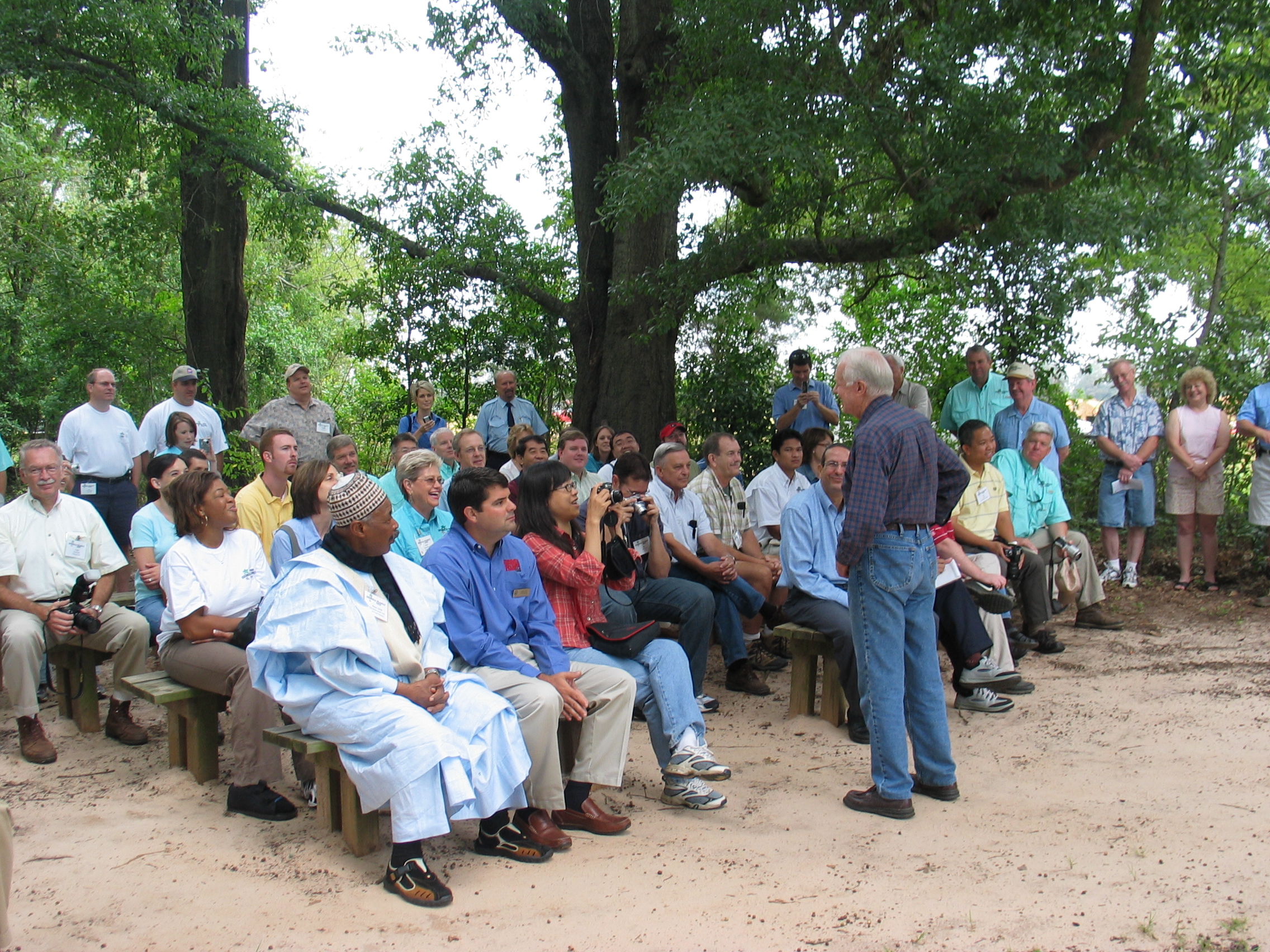 The Georgia Peanut Tour would not have been complete in this area of the state without a visit to the home of the 39th President of the United States Jimmy Carter. Tour attendees were able to visit President Carter’s Boyhood Home and learn first hand about the life of President Carter as a child. President Carter made a suprise visit for the tour and talked about his days living in Plains and then in the White House. President Carter started his peanut business at the young age of five. That’s when he pulled up peanuts from his father’s field, cleaned them and boiled them. He then headed into Plains, Ga. to sale the boiled peanuts. He made money selling the boiled peanuts until he was 8 years old. Today, President Carter and Rosalynn are active with Habitat for Humanity. This weekend, Sept. 27, the town of Plains celebrates with the annual Peanut Festival. There are several activities planned all weekend. Learn more online at the Plains, Georgia web site.
The Georgia Peanut Tour would not have been complete in this area of the state without a visit to the home of the 39th President of the United States Jimmy Carter. Tour attendees were able to visit President Carter’s Boyhood Home and learn first hand about the life of President Carter as a child. President Carter made a suprise visit for the tour and talked about his days living in Plains and then in the White House. President Carter started his peanut business at the young age of five. That’s when he pulled up peanuts from his father’s field, cleaned them and boiled them. He then headed into Plains, Ga. to sale the boiled peanuts. He made money selling the boiled peanuts until he was 8 years old. Today, President Carter and Rosalynn are active with Habitat for Humanity. This weekend, Sept. 27, the town of Plains celebrates with the annual Peanut Festival. There are several activities planned all weekend. Learn more online at the Plains, Georgia web site.
Georgia Peanut Tour Photo Album
Throughout the tour there were hundreds of photos and video taken. A photo album has been created on Flickr. Feel free to download any of these photos for your personal use. More info on Thursday tour stops will be added soon to the blog so check back often.
2008 Georgia Peanut Tour Photo Album
Joel Paz, University of Georgia Extension Agrometeorologist, also created two photo albums.
Check them out too.
Paz’s Photos from President Jimmy Carter visit
Paz’s Photos from Day 2 of the Georgia Peanut Tour
If anyone creates an online photo album of tour photos then email me the link and I’ll be glad to post it on the blog.
Reception & Dinner at the Georgia Agrirama
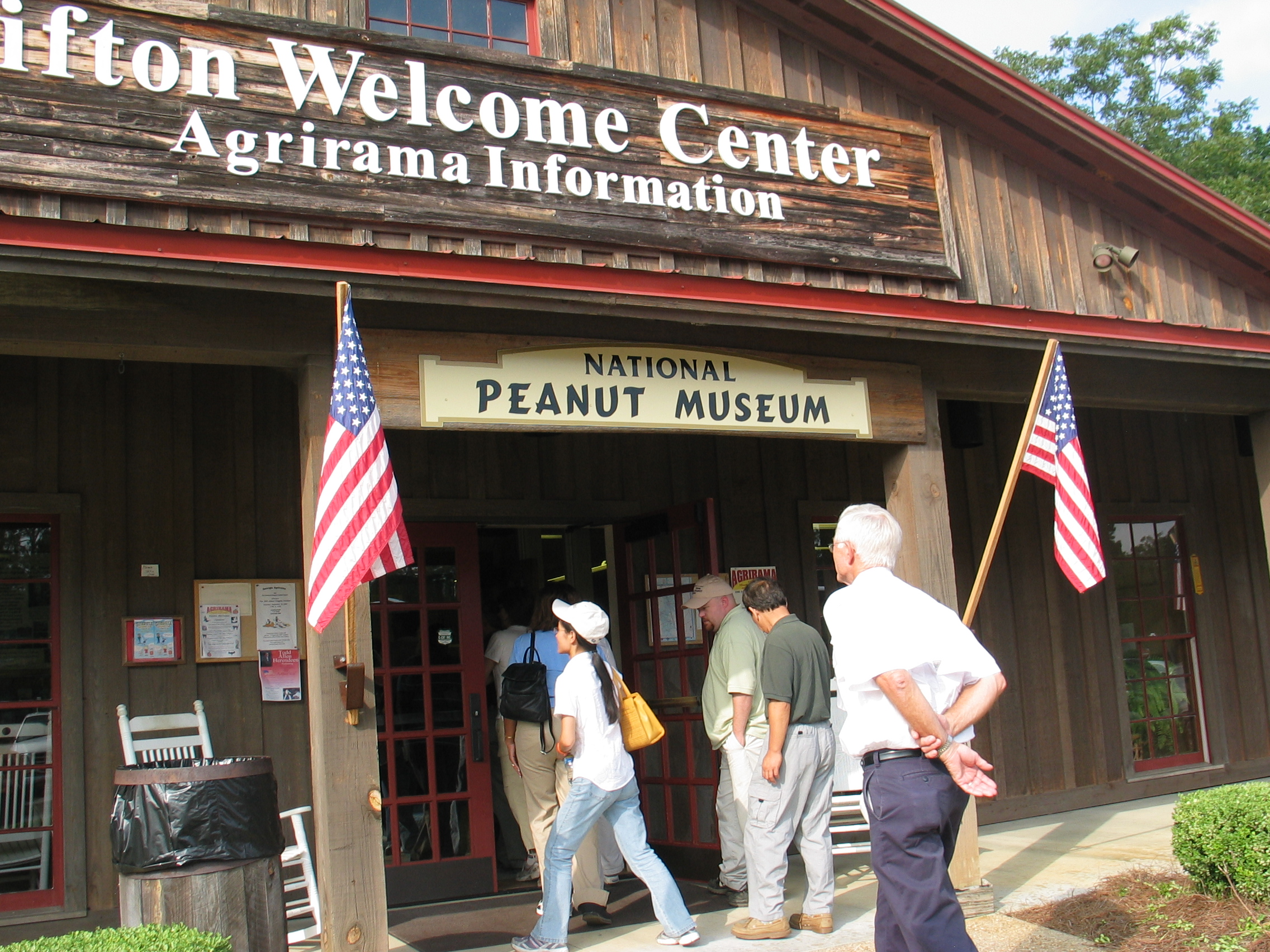 After a long day of traveling around south Georgia, touring several local peanut operations and businesses, the 2008 Georgia Peanut Tour group reached their last stop for the evening – The Georgia Agrirama. At the Agrirama tour participants had the opportunity to visit Georgia’s living museum of Agriculture. The grounds consist of five areas: a traditional farm community of the 1870s, an 1890s progressive farmstead, an industrial sites complex, rural town, national peanut complex, and the Museum of Agriculture Center. Over 35 structures have been relocated to the 95 acre site and faithfully restored or preserved. After touring the grounds of the Agrirama, tourists also had the opportunity to visit another structure found on the site – The National Peanut Museum. This museum is the home to several original peanut diggers and combines, along with several old photographs and artifacts. The museum also has a small theatre where visitors have the opportunity to enjoy a short film that briefly discusses the peanuts history to the industry covering all parts of peanut production – from the farm to the factory. As the tour comes to a close on Wed., tour group members are excited to fellowship together and prepare for another day touring and visiting agricultural operations and businesses that all revolve around one special thing…the peanut. Visit the Agrirama and National Peanut Museum online to learn more about their facilities.
After a long day of traveling around south Georgia, touring several local peanut operations and businesses, the 2008 Georgia Peanut Tour group reached their last stop for the evening – The Georgia Agrirama. At the Agrirama tour participants had the opportunity to visit Georgia’s living museum of Agriculture. The grounds consist of five areas: a traditional farm community of the 1870s, an 1890s progressive farmstead, an industrial sites complex, rural town, national peanut complex, and the Museum of Agriculture Center. Over 35 structures have been relocated to the 95 acre site and faithfully restored or preserved. After touring the grounds of the Agrirama, tourists also had the opportunity to visit another structure found on the site – The National Peanut Museum. This museum is the home to several original peanut diggers and combines, along with several old photographs and artifacts. The museum also has a small theatre where visitors have the opportunity to enjoy a short film that briefly discusses the peanuts history to the industry covering all parts of peanut production – from the farm to the factory. As the tour comes to a close on Wed., tour group members are excited to fellowship together and prepare for another day touring and visiting agricultural operations and businesses that all revolve around one special thing…the peanut. Visit the Agrirama and National Peanut Museum online to learn more about their facilities.
Tift, Turner & Worth County Agriculture Update
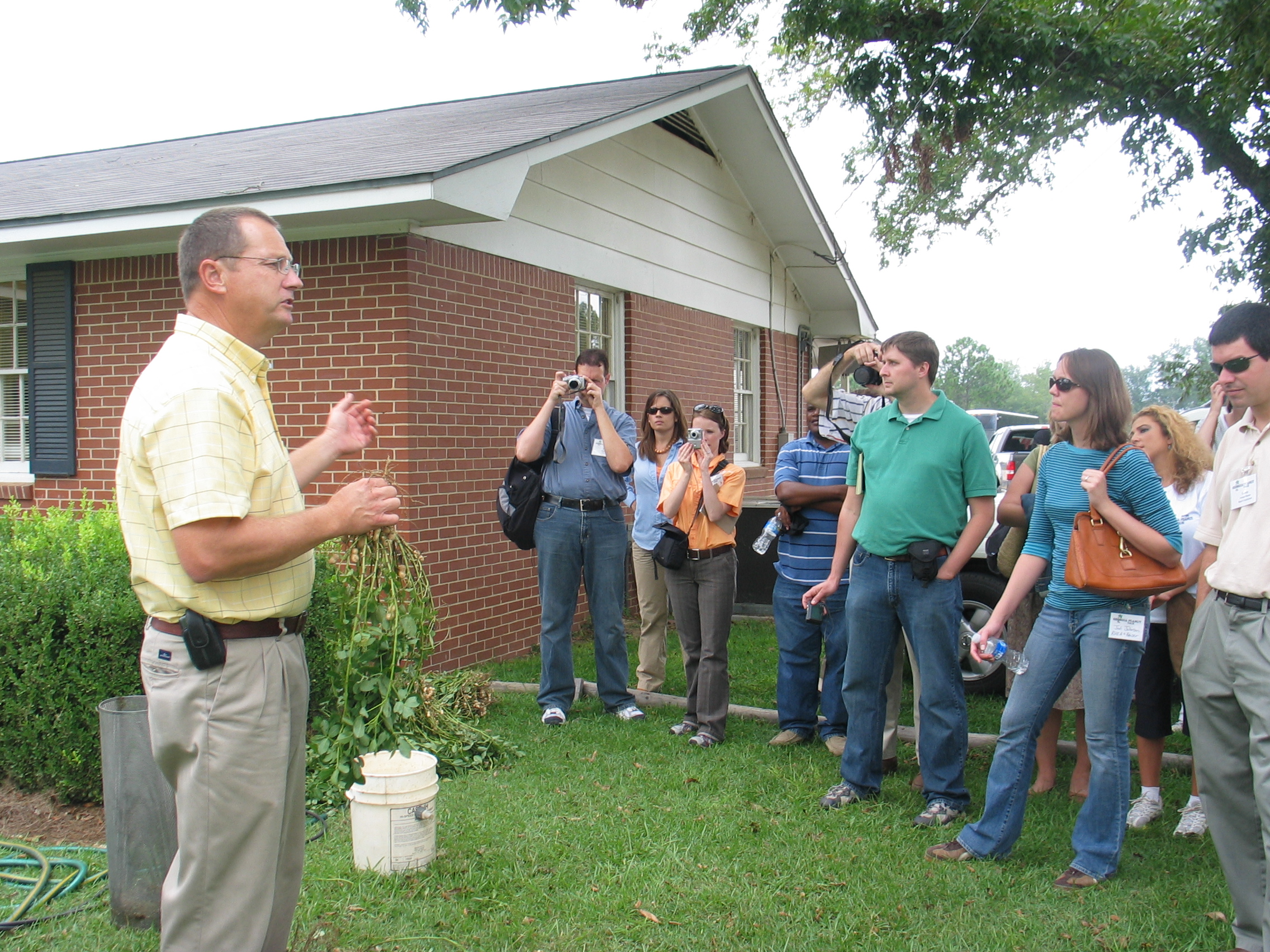 Tift County – Brian Tankersley, Tift County Extension coordinator, provided information to the Georgia Peanut Tour group on agriculture in the county. Tift County farmers planted 16,000 acres of peanuts in 2008. Tankersley estimates production in 2008 at 25,000 tons. The county is very diverse with farmers growing peanuts, cotton, commercial vegetables, corn, soybeans, grain sorghum and small grains. The peanut crop looks good but farmers have had their share of dry weather this year. Farmers were also hit hard by the increasing cost of inputs such as fuel, chemicals and fertilizer. Learn more online at the Tifton and Tift County Tourism Association web site.
Tift County – Brian Tankersley, Tift County Extension coordinator, provided information to the Georgia Peanut Tour group on agriculture in the county. Tift County farmers planted 16,000 acres of peanuts in 2008. Tankersley estimates production in 2008 at 25,000 tons. The county is very diverse with farmers growing peanuts, cotton, commercial vegetables, corn, soybeans, grain sorghum and small grains. The peanut crop looks good but farmers have had their share of dry weather this year. Farmers were also hit hard by the increasing cost of inputs such as fuel, chemicals and fertilizer. Learn more online at the Tifton and Tift County Tourism Association web site.
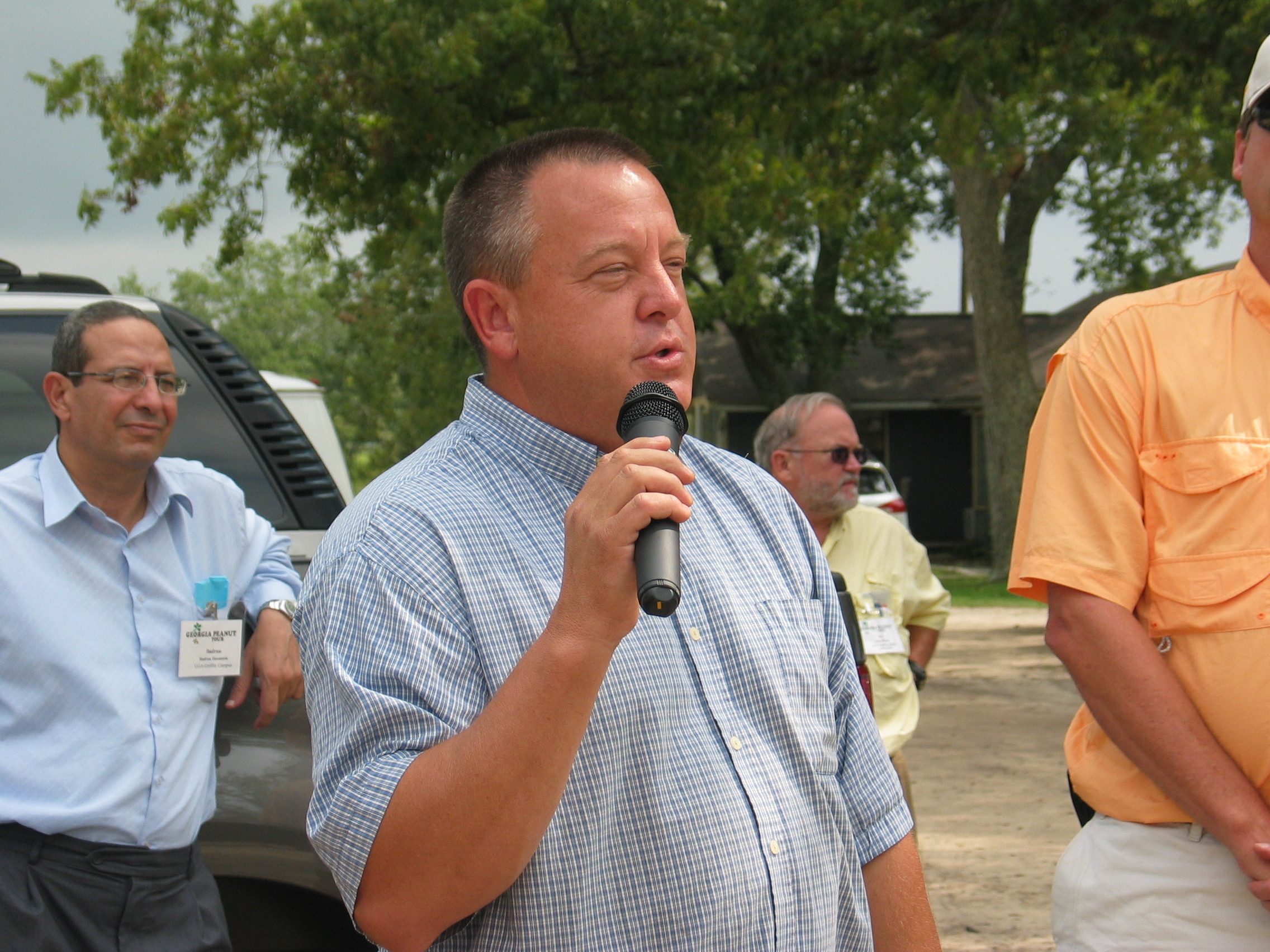 Turner County – Scott Utley, Turner County Extension Coordinator, says the major crops grown in Turner County are peanuts and cotton. Turner County farmers planted 14,000 acres of peanuts this year and Utley estimates production at 1.5 tons per acre. Approximately 60% of the farm land is irrigated in the county. Farmers have also been faced with the drought this year and problems with palmer amaranth. Overall the peanut crop looks good, Utley says. Turner County is also home to the world’s largest peanut. It is located on Interstate 75 at Exit 82 and serves as a monument to Georgia’s Official State Crop – the peanut. The county is also known for it’s popular Fire Ant Festival held the fourth weekend of March. Learn more at the Turner County Chamber of Commerce web site.
Turner County – Scott Utley, Turner County Extension Coordinator, says the major crops grown in Turner County are peanuts and cotton. Turner County farmers planted 14,000 acres of peanuts this year and Utley estimates production at 1.5 tons per acre. Approximately 60% of the farm land is irrigated in the county. Farmers have also been faced with the drought this year and problems with palmer amaranth. Overall the peanut crop looks good, Utley says. Turner County is also home to the world’s largest peanut. It is located on Interstate 75 at Exit 82 and serves as a monument to Georgia’s Official State Crop – the peanut. The county is also known for it’s popular Fire Ant Festival held the fourth weekend of March. Learn more at the Turner County Chamber of Commerce web site.
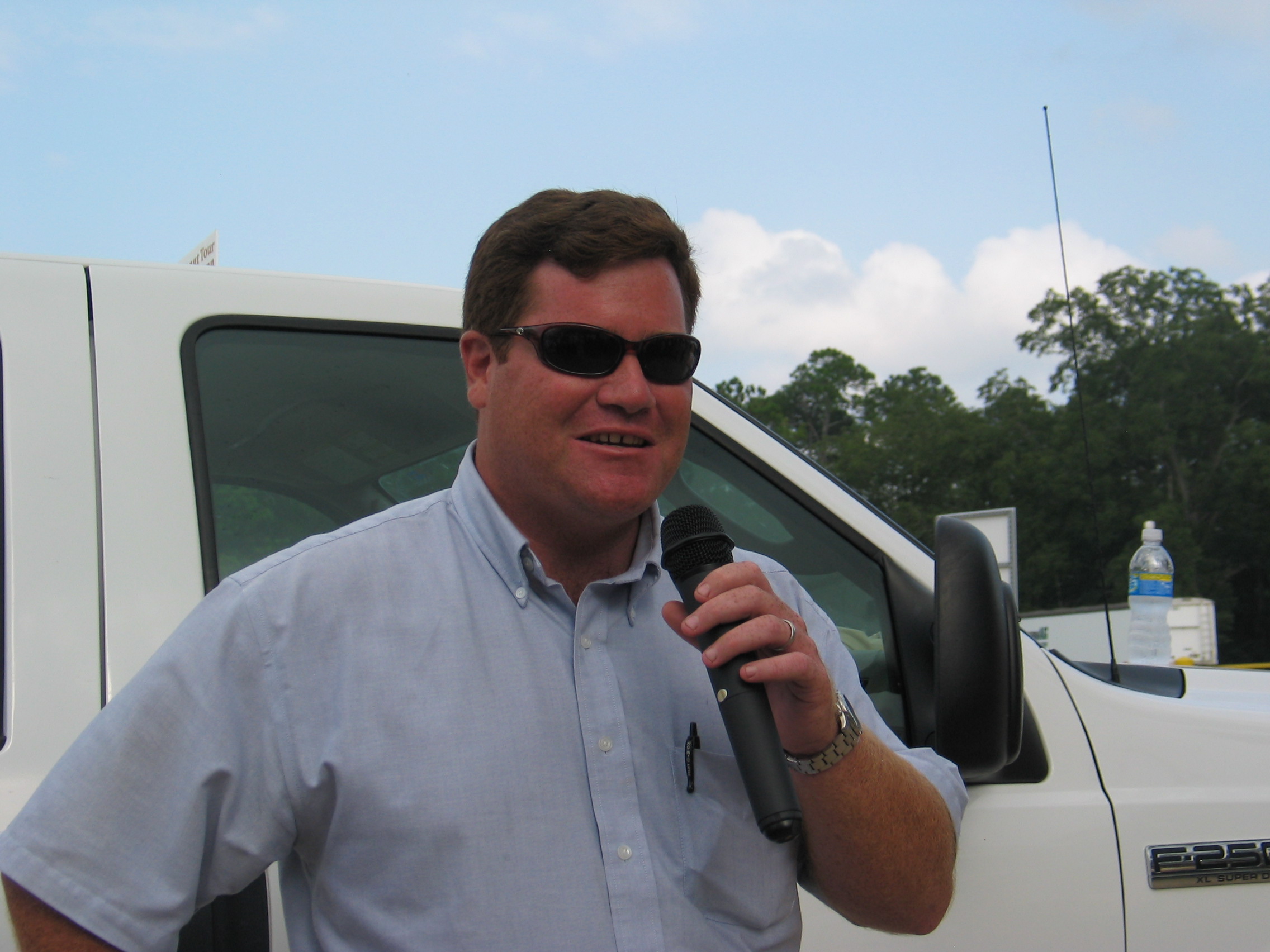 Worth County – Rusty Harris, Worth County Extension Coordinator, provided an update from the Peanut Capitol of the World. Farmers in the county planted 13,935 irrigated acres of peanuts and 20,021 dryland acres of peanuts. Harris expects the production to be 49,424.4 tons. In addition to peanuts, farmers also grow cotton, wheat, corn and soybeans. Farmers in the county have had several issues this year with pigweed, white mold in peanuts, and lesser cornstalk borer damage in peanuts. Farmers have also had weather related trouble with the drought and too much rain at some time during the growing season as well as storm damage. Worth County host the Georgia Peanut Festival the third weekend in October. Did you know that every jar of Peter Pan peanut butter is made right here in Worth County? Learn more online at the Sylvester-Worth County Chamber of Commerce web site.
Worth County – Rusty Harris, Worth County Extension Coordinator, provided an update from the Peanut Capitol of the World. Farmers in the county planted 13,935 irrigated acres of peanuts and 20,021 dryland acres of peanuts. Harris expects the production to be 49,424.4 tons. In addition to peanuts, farmers also grow cotton, wheat, corn and soybeans. Farmers in the county have had several issues this year with pigweed, white mold in peanuts, and lesser cornstalk borer damage in peanuts. Farmers have also had weather related trouble with the drought and too much rain at some time during the growing season as well as storm damage. Worth County host the Georgia Peanut Festival the third weekend in October. Did you know that every jar of Peter Pan peanut butter is made right here in Worth County? Learn more online at the Sylvester-Worth County Chamber of Commerce web site. Grilled PB&J’s
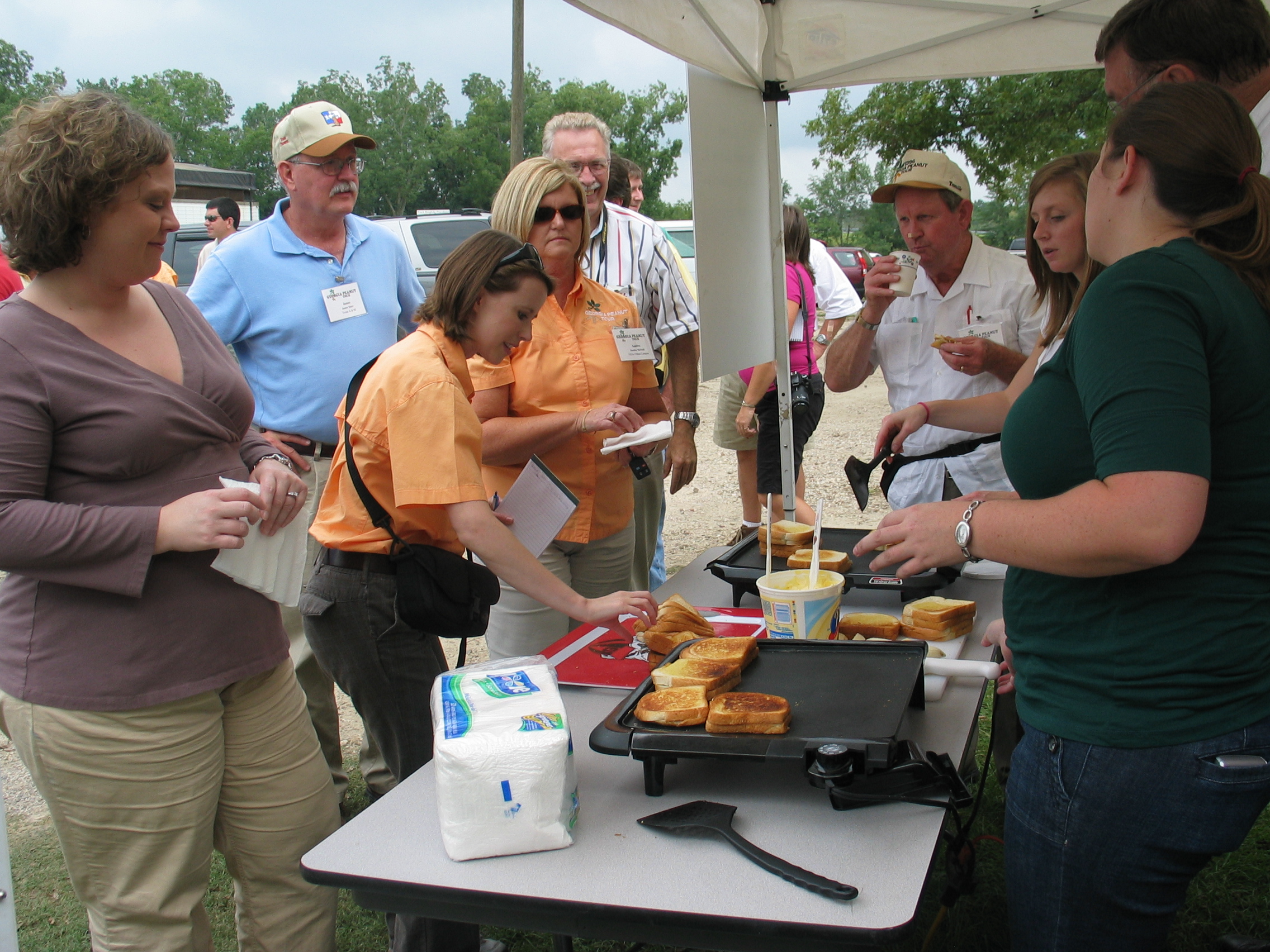 Georgia Peanut Tour attendees received a special treat at the stop at Tifton Quality Peanuts. The National Peanut Buying Points Association was on hand grilling peanut butter sandwiches. The sandwiches are an easy snack to make. According to the chefs, you grill the peanut butter sandwich like you would a grilled cheese sandwich. Ingredients include bread, peanut butter, apple jelly and butter. Of course, if a person wants to try Elvis’ favorite sandwich then add sliced bananas. The chefs are known for grilling these sandwiches at various peanut industry events across the U.S. In the video below they are serving the sandwiches at the Southern Peanut Growers Conference held in July earlier this year.
Georgia Peanut Tour attendees received a special treat at the stop at Tifton Quality Peanuts. The National Peanut Buying Points Association was on hand grilling peanut butter sandwiches. The sandwiches are an easy snack to make. According to the chefs, you grill the peanut butter sandwich like you would a grilled cheese sandwich. Ingredients include bread, peanut butter, apple jelly and butter. Of course, if a person wants to try Elvis’ favorite sandwich then add sliced bananas. The chefs are known for grilling these sandwiches at various peanut industry events across the U.S. In the video below they are serving the sandwiches at the Southern Peanut Growers Conference held in July earlier this year.
